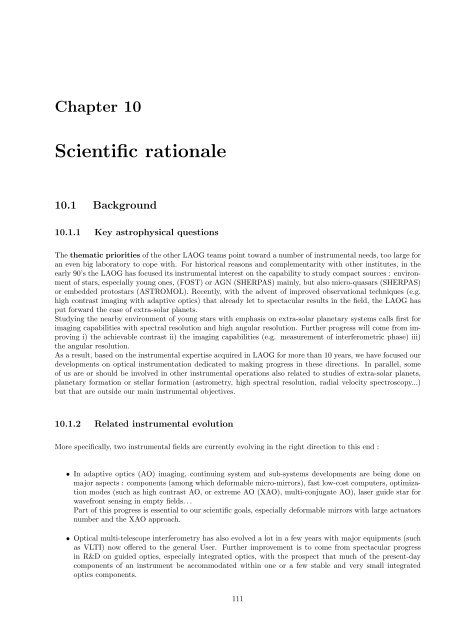Untitled - Laboratoire d'Astrophysique de l'Observatoire de Grenoble
Untitled - Laboratoire d'Astrophysique de l'Observatoire de Grenoble
Untitled - Laboratoire d'Astrophysique de l'Observatoire de Grenoble
You also want an ePaper? Increase the reach of your titles
YUMPU automatically turns print PDFs into web optimized ePapers that Google loves.
Chapter 10<br />
Scientific rationale<br />
10.1 Background<br />
10.1.1 Key astrophysical questions<br />
The thematic priorities of the other LAOG teams point toward a number of instrumental needs, too large for<br />
an even big laboratory to cope with. For historical reasons and complementarity with other institutes, in the<br />
early 90’s the LAOG has focused its instrumental interest on the capability to study compact sources : environment<br />
of stars, especially young ones, (FOST) or AGN (SHERPAS) mainly, but also micro-quasars (SHERPAS)<br />
or embed<strong>de</strong>d protostars (ASTROMOL). Recently, with the advent of improved observational techniques (e.g.<br />
high contrast imaging with adaptive optics) that already let to spectacular results in the field, the LAOG has<br />
put forward the case of extra-solar planets.<br />
Studying the nearby environment of young stars with emphasis on extra-solar planetary systems calls first for<br />
imaging capabilities with spectral resolution and high angular resolution. Further progress will come from improving<br />
i) the achievable contrast ii) the imaging capabilities (e.g. measurement of interferometric phase) iii)<br />
the angular resolution.<br />
As a result, based on the instrumental expertise acquired in LAOG for more than 10 years, we have focused our<br />
<strong>de</strong>velopments on optical instrumentation <strong>de</strong>dicated to making progress in these directions. In parallel, some<br />
of us are or should be involved in other instrumental operations also related to studies of extra-solar planets,<br />
planetary formation or stellar formation (astrometry, high spectral resolution, radial velocity spectroscopy...)<br />
but that are outsi<strong>de</strong> our main instrumental objectives.<br />
10.1.2 Related instrumental evolution<br />
More specifically, two instrumental fields are currently evolving in the right direction to this end :<br />
• In adaptive optics (AO) imaging, continuing system and sub-systems <strong>de</strong>velopments are being done on<br />
major aspects : components (among which <strong>de</strong>formable micro-mirrors), fast low-cost computers, optimization<br />
mo<strong>de</strong>s (such as high contrast AO, or extreme AO (XAO), multi-conjugate AO), laser gui<strong>de</strong> star for<br />
wavefront sensing in empty fields. . .<br />
Part of this progress is essential to our scientific goals, especially <strong>de</strong>formable mirrors with large actuators<br />
number and the XAO approach.<br />
• Optical multi-telescope interferometry has also evolved a lot in a few years with major equipments (such<br />
as VLTI) now offered to the general User. Further improvement is to come from spectacular progress<br />
in R&D on gui<strong>de</strong>d optics, especially integrated optics, with the prospect that much of the present-day<br />
components of an instrument be accommodated within one or a few stable and very small integrated<br />
optics components.<br />
111




